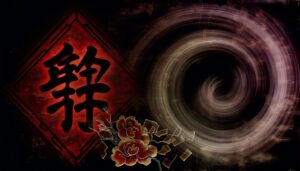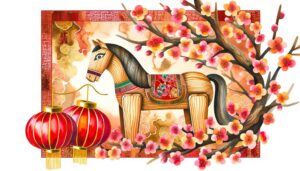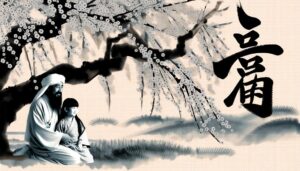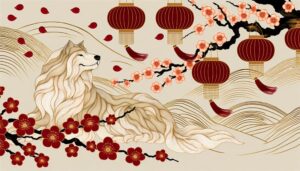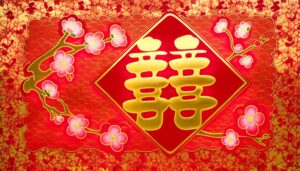What Is the Chinese Symbol for Dragon Year?
The Chinese symbol for the Year of the Dragon is 龍 (Lóng). Deeply rooted in Chinese mythology, it traces back to the Neolithic period and was formalized during the Shang and Zhou dynasties.
The dragon symbolizes power, strength, courage, wisdom, and prosperity. It historically links to imperial power and is believed to bring good fortune and success.
In Chinese culture, dragons control water, rainfall, and floods, symbolizing harmony between nature and humanity. This revered symbol notably impacts cultural celebrations and personal decisions.
Exploring its multifaceted influence will reveal its enduring presence in Chinese heritage and beyond.
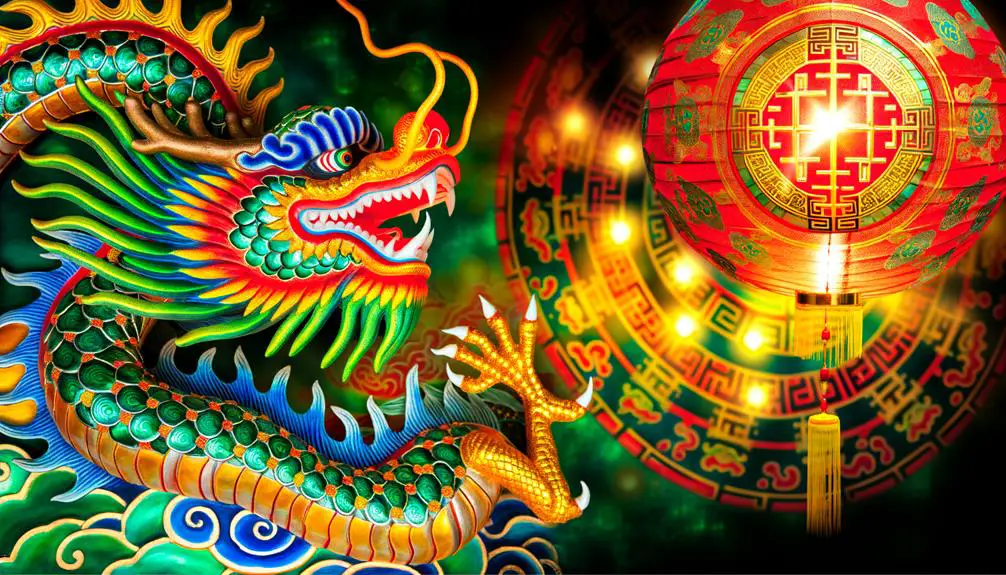
Key Takeaways
- The Chinese symbol for the Year of the Dragon is "龙" (Lóng).
- It signifies power, strength, and good fortune in Chinese culture.
- Historically linked to emperors, symbolizing leadership and wisdom.
- Associated with prosperity and success in Chinese cosmology.
- Depicted in art, festivals, and zodiac celebrations as a revered cultural emblem.
Historical Origins
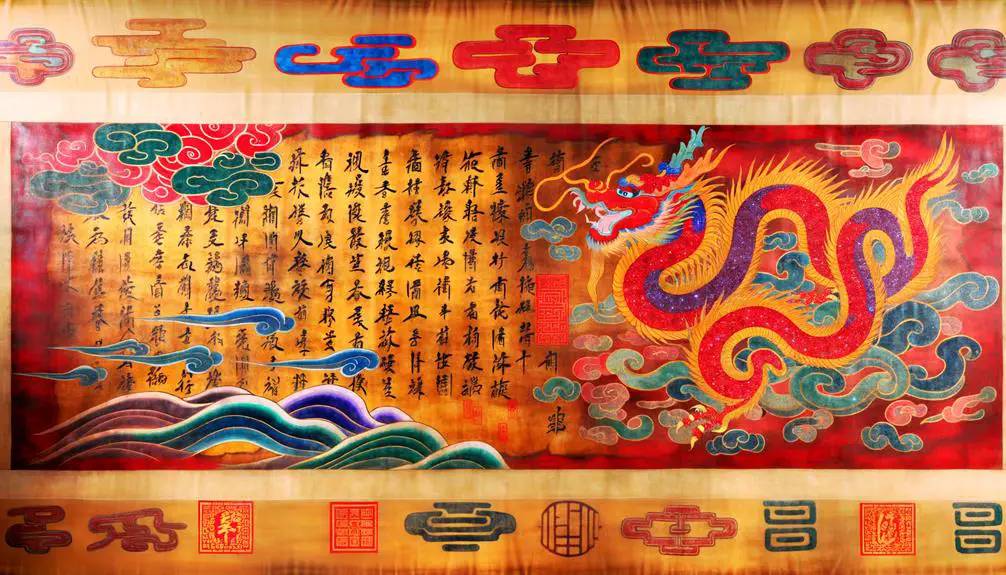
The historical origins of the Chinese symbol for the Year of the Dragon are deeply intertwined with ancient Chinese mythology and the development of the Chinese writing system. Rooted in prehistoric times, the dragon symbol evolved from early depictions of mythological creatures amalgamating serpentine, avian, and mammalian characteristics.
These early representations can be traced back to the Neolithic period, where pottery and jade artifacts bear proto-dragon imagery. The formalization of the dragon symbol occurred during the Shang and Zhou dynasties, as the Chinese script matured. Oracle bone inscriptions and bronze vessel engravings reveal the gradual stylization of the dragon character.
The symbol's evolution reflects both artistic influences and the sociopolitical significance attributed to the dragon in ancient Chinese culture.
Symbolic Meaning
The Chinese symbol for the Year of the Dragon embodies multifaceted meanings that are deeply rooted in cultural and historical contexts. It signifies power and strength, often associated with imperial authority and celestial prowess, while also representing luck and prosperity, promising good fortune and success.
Moreover, its cultural significance extends beyond mere symbolism, influencing art, literature, and societal values in profound ways.
Power and Strength
Embodying an unparalleled blend of power and strength, the Chinese symbol for the Year of the Dragon has long been revered in both historical and cultural contexts. This symbol signifies not only physical prowess but also an indomitable spirit, making it a cornerstone of Chinese mythology.
Historically, it has been associated with emperors, who were often seen as dragons in human form. Culturally, it represents a life force that is vibrant and potent.
The symbolic meaning can be broken down into four key aspects:
- Physical Strength: Dragons are often depicted as mighty and formidable creatures.
- Authority: Historically linked to imperial power.
- Courage: Embodies bravery and resilience.
- Leadership: Symbolizes wisdom and the ability to lead effectively.
These facets collectively underscore the dragon's revered status.
Luck and Prosperity
Beyond its associations with power and strength, the Chinese symbol for the Year of the Dragon is also deeply intertwined with notions of luck and prosperity. This symbolic connection is rooted in ancient Chinese cosmology, where dragons are revered as divine creatures capable of summoning rain, a crucial element for agricultural success. Consequently, dragons are seen as harbingers of bountiful harvests and economic prosperity.
Additionally, the dragon is often depicted as a guardian of treasures, further reinforcing its association with wealth and good fortune. In the context of personal aspirations, individuals born in the Year of the Dragon are believed to possess innate luck and an enhanced capacity to attract success and prosperity in their endeavors, further solidifying this symbol's auspicious reputation.
Cultural Significance
In Chinese culture, the dragon symbol serves as a multifaceted emblem encompassing power, wisdom, and an indomitable spirit. This revered creature transcends mere mythology to embody deep-seated cultural values, reflecting both historical and contemporary significance.
The dragon's symbolic meaning can be distilled into four core elements:
- Authority and Sovereignty: Dragons are historically linked to emperors, symbolizing supreme authority.
- Intelligence and Enlightenment: They are considered wise, signifying intellectual prowess and enlightenment.
- Strength and Resilience: The dragon's formidable presence epitomizes physical and spiritual strength.
- Good Fortune and Prosperity: As harbingers of good luck, dragons are believed to attract prosperity and success.
Understanding these elements provides a nuanced appreciation of the dragon's integral role in Chinese culture.
Cultural Significance
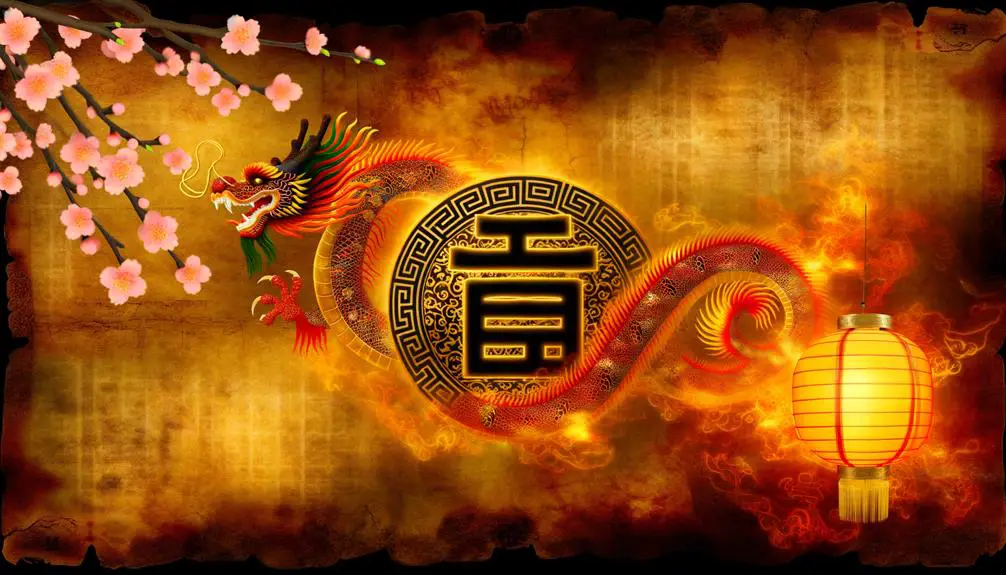
The cultural significance of the Chinese symbol for the Year of the Dragon is multifaceted, encompassing its symbolic meaning, its role in traditional folklore, and its influence within the modern zodiac system.
Historically, dragons have been emblematic of power, strength, and auspiciousness in Chinese culture, often depicted in myths and legends that underscore their revered status.
Today, the dragon continues to hold significant sway, shaping contemporary celebrations and perceptions associated with the Chinese zodiac.
Symbolic Meaning Explained
Rooted in millennia-old traditions, the symbolic meaning of the Chinese Year of the Dragon reflects a confluence of cultural beliefs, mythological narratives, and historical significance. In Chinese culture, the dragon is not merely a creature of legend but an emblem of auspicious power.
The symbolism can be dissected into four primary elements:
- Power and Authority: Representing imperial strength, the dragon is often associated with emperors.
- Prosperity and Wealth: The dragon's presence is believed to attract fortune and success.
- Wisdom and Knowledge: Dragons symbolize deep understanding and intellectual pursuit.
- Luck and Protection: Dragons are seen as guardians that ward off evil and bring good luck.
This multi-faceted symbolism underscores the dragon's esteemed position within Chinese cultural heritage.
Dragon in Folklore
Beyond its symbolic meanings, the dragon's depiction in Chinese folklore highlights its profound cultural significance and its integral role in shaping societal values and beliefs. The dragon is often seen as a benevolent creature, symbolizing power, strength, and good fortune. It is believed to control water, rainfall, and floods, which are essential for agriculture in traditional Chinese society. Therefore, the dragon embodies a harmonious balance between nature and humanity, reinforcing the importance of respect for natural forces.
| Folklore Element | Symbolism | Cultural Role |
|---|---|---|
| Water Control | Power and Strength | Guarantees agricultural prosperity |
| Rainfall | Abundance | Facilitates sustenance and growth |
| Floods | Balance | Emphasizes harmony between nature and man |
| Benevolent Nature | Good Fortune | Promotes societal well-being and success |
This cultural portrayal underscores the dragon's enduring presence in Chinese heritage.
Zodiac Influence Today
In contemporary society, the influence of the Chinese zodiac, particularly the Year of the Dragon, manifests in various cultural, economic, and personal aspects. The Dragon, symbolizing power, success, and fortune, profoundly impacts modern life.
- Cultural Celebrations: Festivals and rituals honor the Dragon, fostering community cohesion and cultural heritage.
- Economic Activities: Businesses launch products and promotions aligned with the Dragon's auspicious symbolism, boosting consumer spending.
- Personal Decisions: Individuals plan major life events, such as weddings and childbirth, during the Year of the Dragon, believing it brings prosperity.
- Media Representation: The Dragon features prominently in films, literature, and art, perpetuating its legendary status and influence.
Thus, the Year of the Dragon continues to shape contemporary practices and perceptions.
Artistic Representations
Artistic representations of the Chinese symbol for the Year of the Dragon are deeply intertwined with cultural symbolism and historical context, reflecting the significance of the dragon in Chinese mythology and art. Renowned for embodying power, strength, and good fortune, the dragon symbol is often depicted through intricate calligraphy, elaborate paintings, and sculptures.
These artistic forms capture not only the dragon's physical attributes but also its mythical essence, often surrounded by clouds or water to signify its celestial and aquatic dominions. The use of vivid colors like red and gold further accentuates the dragon's auspicious nature.
Such representations are not merely decorative but serve as profound expressions of cultural identity, embodying centuries of tradition and belief in the dragon's benevolent influence.
Celebratory Practices
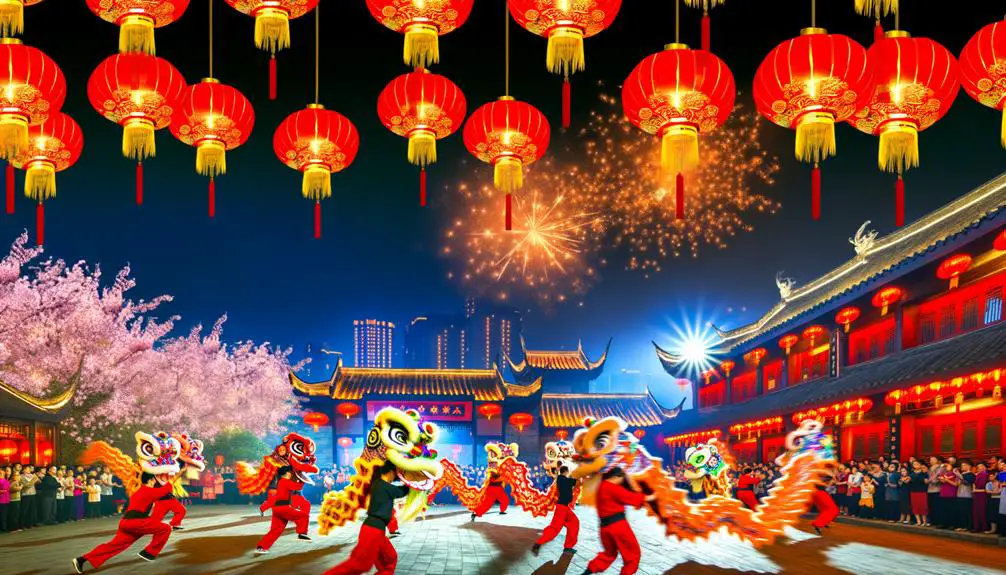
The profound cultural significance of the dragon symbol is vividly manifested in various celebratory practices during the Year of the Dragon, where rituals and festivities underscore the dragon's revered status in Chinese tradition. These practices reflect the dragon's association with power, prosperity, and good fortune.
Key celebratory activities include:
- Dragon Dances: Elaborate performances featuring dragon puppets symbolize strength and auspiciousness.
- Fireworks Displays: Pyrotechnics are used to ward off evil spirits and attract prosperity.
- Temple Offerings: Devotees present incense, food, and other offerings to honor deities associated with the dragon.
- Family Reunions: Families gather to share meals and exchange gifts, reinforcing social bonds and collective well-being.
Each of these practices enhances the cultural tapestry, reiterating the dragon's esteemed role in Chinese heritage.
Zodiac Compatibility
Zodiac compatibility, a pivotal aspect of Chinese astrology, examines the harmonious and discordant relationships among the twelve animal signs, providing insights into interpersonal dynamics and potential challenges. Each sign interacts uniquely with others, influencing romantic relationships, friendships, and business partnerships. Understanding these compatibilities can guide individuals in fostering more productive and harmonious interactions. Below, a simplified table illustrates compatibility for the Dragon:
| Zodiac Sign | Compatible Signs | Incompatible Signs |
|---|---|---|
| Dragon | Rat, Monkey, Rooster | Dog, Rabbit |
| Rat | Dragon, Monkey, Ox | Horse, Goat |
| Monkey | Dragon, Rat, Snake | Tiger, Pig |
| Rooster | Dragon, Ox, Snake | Rabbit, Dog |
| Ox | Rat, Rooster, Snake | Goat, Horse |
Such compatibilities are rooted in cultural beliefs and historical observations, reflecting the complexity of human relationships.
Global Influence
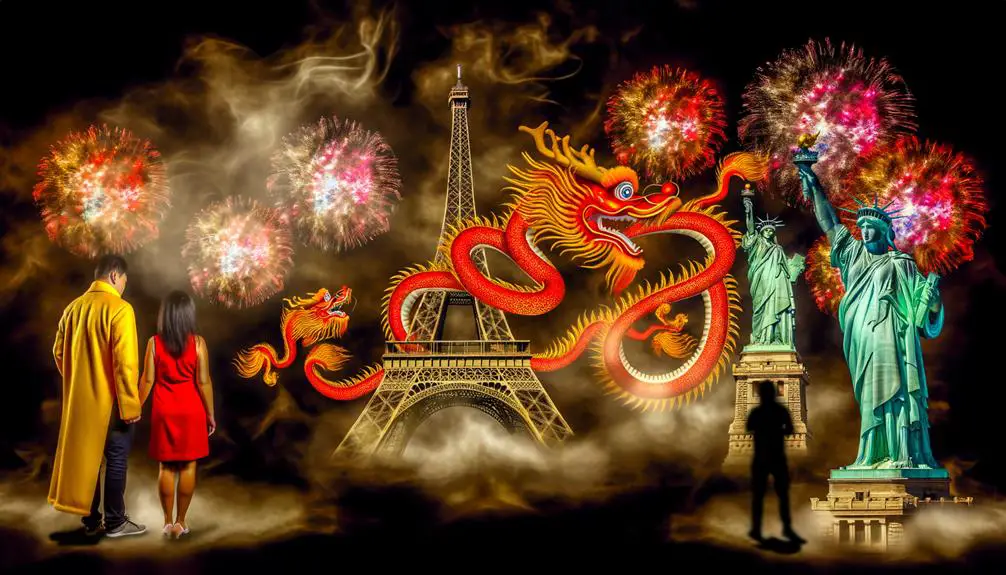
Chinese astrology, particularly the symbolism of the Year of the Dragon, has profoundly permeated global cultures, influencing various domains such as art, literature, and popular media. This mythical creature, emblematic of power, strength, and good fortune, has transcended its origins and has been adopted in diverse cultural expressions worldwide.
The influence can be categorized into several key areas:
- Art: Dragon motifs are prevalent in global artworks, from traditional paintings to contemporary installations.
- Literature: Many authors incorporate dragons as central figures in fantasy and mythological genres.
- Cinema: Dragons feature prominently in global film industries, symbolizing various themes.
- Fashion: Dragon-inspired designs are popular in global fashion, symbolizing elegance and mystery.
This multifaceted influence underscores the dragon's universal appeal and symbolic richness.
Conclusion
The Chinese symbol for the Year of the Dragon encapsulates a rich tapestry of historical origins, symbolic meanings, and cultural significance.
Artistic representations and celebratory practices give life to its legacy, while zodiac compatibility and global influence extend its reach.
This symbol serves as a beacon, guiding a ship through the vast ocean of cultural heritage.
The dragon's essence is interwoven into the very fabric of identity, resonating deeply within the collective consciousness.

